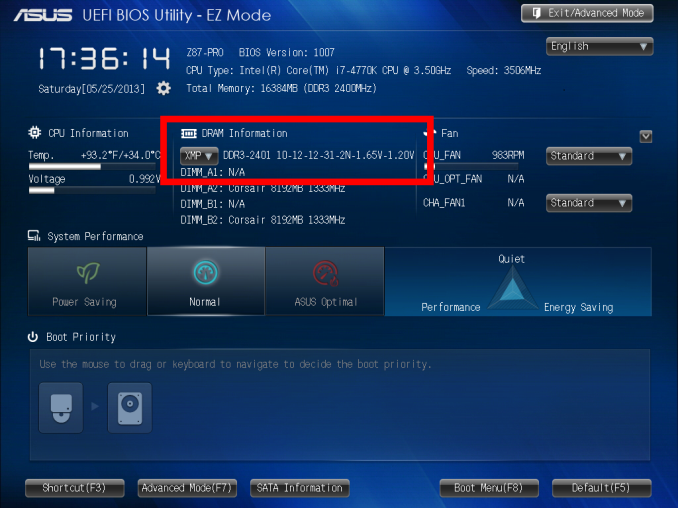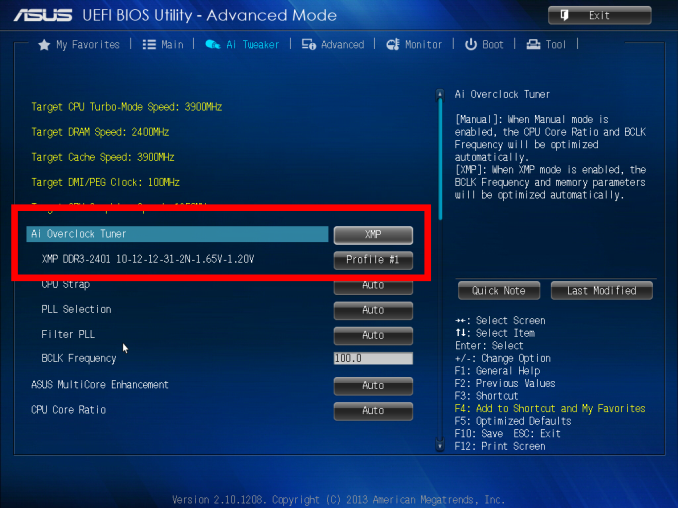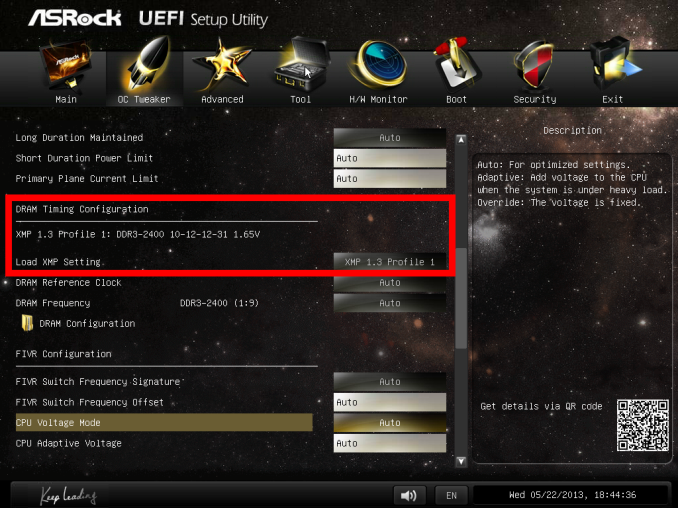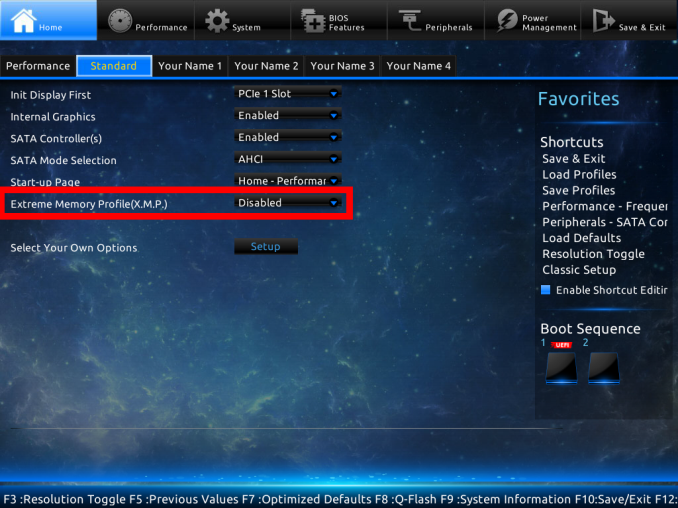Memory Scaling on Haswell CPU, IGP and dGPU: DDR3-1333 to DDR3-3000 Tested with G.Skill
by Ian Cutress on September 26, 2013 4:00 PM ESTEnabling XMP with ASUS, GIGABYTE, ASRock and MSI on Z87
By default, memory should adhere to specifications set by JEDEC (formerly known as the Joint Electron Device Engineering Council). These specifications state what information should be stored in the memory EEPROM, such as manufacturer information, serial number, and other useful information. Part of this are the memory specifications for standard memory speeds, including (for DDR3) 1066 MHz, 1333 MHz and 1600 MHz, which a system will adhere to in the event of other information not being available.
An XMP, or (Intel-developed) Extreme Memory Profile, is an additional set of values stored in the EEPROM which can be detected by SPD in the BIOS. Most DRAM has space for two additional SPD profiles, sometimes referred to as an ‘enthusiast’ and an ‘extreme’ profile; however most consumer oriented modules may only have one XMP profile. The XMP profile is typically the one advertised on the memory kit – if the capability of the memory deviates in any way from specified JEDEC timings, a manufacturer must use an XMP profile.
Thus it is important that the user enables XMP! It is not plug and play!
At big computing events and gaming LANs there are plenty of enthusiasts who boast about buying the best hardware for their system. If you ask what memory they are running, then actually probe the system (by using CPU-Z), I sometimes find that the user, after buying expensive memory, has not enabled XMP! It sounds like a joke story, but this happened several times at my last iSeries LAN in the UK – people boasting about high performance memory, but because they did not enable it in the BIOS, were still running at DDR3-1333 MHz C9.
So enable XMP with your memory!
Here is how:
Step 1: Enter the BIOS
This is typically done by pressing DEL or F2 during POST/startup. Users who have enabled fast booting under Windows 8 will have to use vendor software to enable ‘Go2BIOS’ or a similar feature.
Step 2: Enable XMP
Depending on your motherboard manufacturer, this will be different. I have taken images from the major four motherboard manufacturers to show where the setting is on some of the latest Z87 motherboard models.
On the ASUS Z87-Pro, the setting is on the EZ-Mode screen. Where it says ‘XMP’ in the middle, click on this button and navigate to ‘Profile 1’:
If you do not get an EZ mode (some ROG boards go straight to advanced mode), then the option is under the AI Tweaker tab, in the AI Overclock Tuner option.
For ASRock motherboards, navigate to OC Tweaker and scroll down to the DRAM Timing Configuration. Adjust the ‘Load XMP Setting’ option to Profile 1.
For GIGABYTE motherboards, such as the Z87X-UD3H in the new HD mode, under Home -> Standard is the separate XMP setting, as shown below:
Finally on MSI motherboards, select to the OC option on the left hand side and XMP should be in front of you:
I understand that setting XMP may seem trivial to most of AnandTech’s regular readers, however for completeness (and the lack of XMP being enabled at events it seems) I wanted to include this mini-guide. Of course different BIOS versions on different motherboards may have moved the options around a little – either head to enthusiast forums, or if it is a motherboard I have reviewed, I post up all the screenshots of the BIOS I tested with as a guide.















89 Comments
View All Comments
Nagorak - Thursday, September 26, 2013 - link
Why did memory prices fluctuate so much since the end of last year and now? The Hynix fire looks to have next to no impact, but the price of memory has nearly doubled since last November/December.aryonoco - Thursday, September 26, 2013 - link
Ian, I do not want to disparage your work, please take this as nothing but constructive criticism. You do amazing work and the wealth of technical expertise is very clear in your articles.But you have a terrible writing style. There are so many sentences in your articles that while technically grammatically correct, are the most awkward ways of saying what you mean. Take a very simple sentence: "In terms of real world usage, on our Haswell platform, there are some recommendations to be made." There are so many ways, much simpler, much cleaner, much shorter to say what you said in that sentence.
I really struggle with your writing style. I know journalism isn't really your day job and you have a lot of important things to attend to, but please, if you care about this side job of yours as a technical writer, being technical is only half the story. Please consider improving your writing style to make it more readable.
Bob Todd - Friday, September 27, 2013 - link
I'd wager most of the readers didn't struggle as mightily as you. If you want to critique another's wordsmithery, you might want to find a classier way to do it. Our first exhibit will be sentence one of paragraph two. Surely you could have strung together a couple of words that got your point across without sounding like an ass?Impulses - Friday, September 27, 2013 - link
Yeah, I'm pretty sure that starting a sentence with a But is something you'd typically avoid...Dustin Sklavos - Friday, September 27, 2013 - link
"You have a terrible writing style."Constructive!
How would you like it if someone came to your place of business and told you "Look, I don't mean to disparage your work, but it makes my cat's hair fall out in clumps."
ingwe - Friday, September 27, 2013 - link
Yep. This definitely wasn't constructive.Ian, I don't see anything wrong with your writing, and I would rather you concentrate on getting articles out than on spending lots of extra time on editing your work.
jaded1592 - Sunday, September 29, 2013 - link
Your first sentence is grammatically incorrect. Stones and glass houses...Sivar - Thursday, September 26, 2013 - link
What a great article. Tons of actual data, and the numerous charts weren't stupidly saved as JPG. I love Anandtech.soccerballtux - Thursday, September 26, 2013 - link
so bandwidth starved apps with predictable data requests (h264 p1) really like it but when the CPU has enough data to crunch (winrar) the lower real-world latency time in seconds is worth having.gandergray - Thursday, September 26, 2013 - link
Ian: Thank you for the excellent article. You provide in depth and thorough analysis. Your article will undoubtedly serve as a frequently referenced guide.